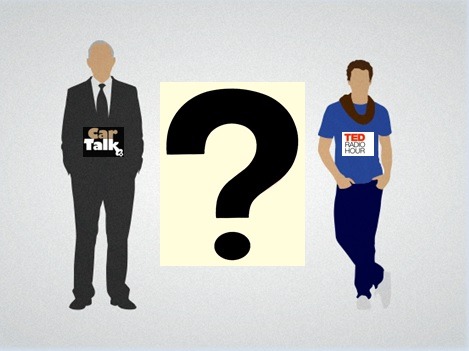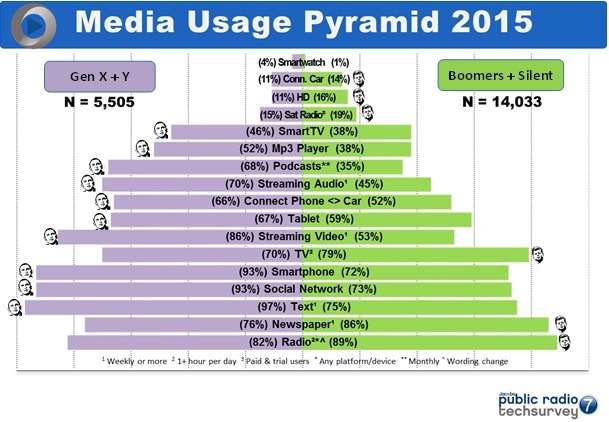Radio’s industry trades were treated to an avalanche of coverage yesterday about a precipitous drop in public radio news listening.
Driven by an article in Current.org (“Drop in younger listeners makes dent in NPR news audience”) written by Tyler Falk, the issue revolves around Nielsen data that shows older listeners are holding public radio’s ratings together, while losses pile up among the 54 and under set.
This is a clarion call to public radio programmers, researchers, and executives that research, strategies, and solutions are mandatory if the system is to survive, thrive, and prosper over the next several years. Clearly, public radio has made great strides in its digitally-rooted programs, apps, and initiatives. But like other traditional media outlets (think The New York Times), those digital gains don’t offset the losses in Nielsen listening.
And once again, a root problem that defines this cataclysmic transition revolves around how measurement of these digital assets lags behind traditional metered and diary ratings, leaving the system in an uncomfortable lurch. Are younger listeners disinterested in public radio, or are they rapidly moving to the wide open digital spaces where metrics and measurement are still being perfected? Are they consuming public radio shows and hosts on podcasts and apps as they gravitate away from the FM band?
At last month’s Public Radio Program Directors convention, this was a major topic. I had the opportunity to present salient parts of our PRTS7 study that outlined some of these key issues facing public radio’s apparent shrinkage. And my choice was to highlight this generational divide because it goes a long way toward defining the horns of this dilemma.
Like other mainstream media outlets, many in public radio find themselves challenged to please everyone. Whether its creating terrestrial and digital programming or the devices that carry them, consumers have never had so many choices.
You can see this in the “dual pyramid” I showed at PRPD, juxtaposing Boomers and Silents with Generations X and Y. In just about every new media dimension – save for paying for satellite radio, having an HD radio, and owning a “connected car” – the younger generations are operating on very different platforms, challenging public radio stations to keep up, morph, and adapt.
Using little icons that symbolize these generations, the little JFKs point to greater usage of traditional media by the older generations: TV, radio, and newspapers. And in greater multitude, the mini Obamas underscore just how expansively members of Gens X and Y live their connected lives:
From social media to streaming to smart TVs to smartphones, these new legions of media consumers are engaged in gadgets, web content, and digital activities that often confuse and perplex their parents and grandparents. To media producers, the challenge is on to create credible content in ever-expanding spaces, as the ratings indicate the drip drip drip of eroding listenership.
For programmers,, it’s the best of times and the worst of times. Experimentation and innovation have never been more necessary and welcomed. And for creative types, that’s a blessing. But the downside is that the tried and true formula for ratings and pledge drive success has never been more challenged by the decline of the public radio business as usual model.
To public radio’s credit, most of the key players are asking the right questions and seeking out viable answers, while unafraid to challenge the status quo. Conversations are now taking place in all corners of public radio, framing a strong willingness to admit problems, and face them head on.
In contrast, Tom Taylor’s column yesterday raised the ugly issue that commercial radio’s news/talk stations are in more precarious shape. The demographics for these brands have been aging and shrinking for some time now. And yet, full speed ahead for so many commercial stations as they continue to ride it out, hoping for miracle that somehow ushers in a shift in tastes, politics, or even a Voltair “Hail Mary.”
If there are answers to these existential questions, public radio will figure them out. Like other traditional media organisms, there are some in public radio that cling to a safer, more dependable past. But for so many more, the drumbeat of change is getting louder – some might even say deafening – and the best and brightest in the system are already engaged and asking the right questions.
But this is a situation for both commercial and public radio where past is not prologue. The ways and means by which public radio built its traditional audience may not translate to the more complex challenges of winning over new listeners. While the core values of the public radio product remain intact and relevant for both Boomers and Millennials, there are different rules and nuances when it comes to tone, style, transparency, and even the ways in which content is accessed that requires a completely fresh look at the existing model.
This shouldn’t surprise anyone. Back in 2007, we presented “The Bedroom Project” at the NAB Radio Show in conjunction with Arbitron. By observing the way that our young 17-28 year-olds were accessing media back then, it was apparent the entire foundation of the radio broadcasting industry was about to change.
How did we know? All we had to do was to ask them if they had a radio in their home.
If podcasting is public radio’s digital canary in the coalmine, programmers, managers, and executives are already well down the path of learning from the failures and successes of on-demand radio. Apps like NPR One are experiments that show that, in fact, public radio can play by the new rules.
Game on.
- The Exponential Value of Nurturing Radio Superfans - April 28, 2025
- What To Do If Your Radio Station Goes Through A Midlife Crisis - April 25, 2025
- A 2020 Lesson?It Could All Be Gone In A Flash - April 24, 2025






Leave a Reply